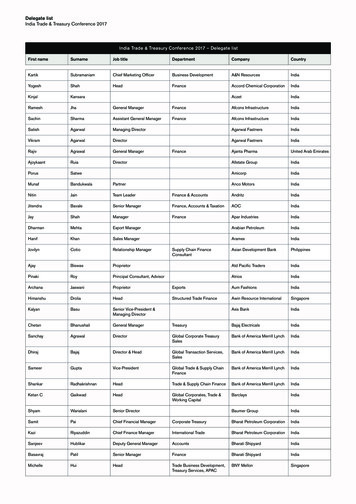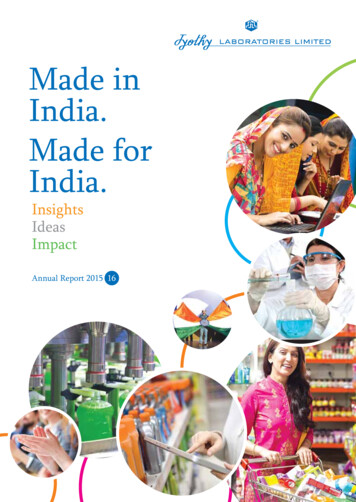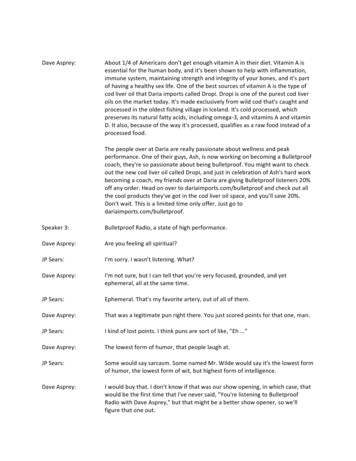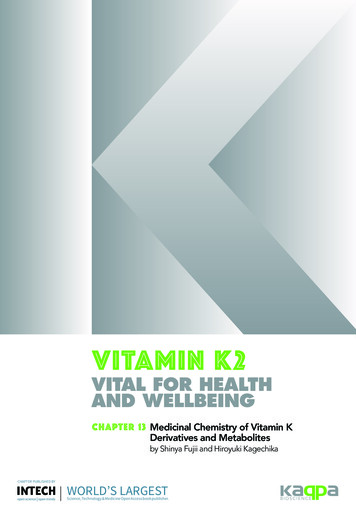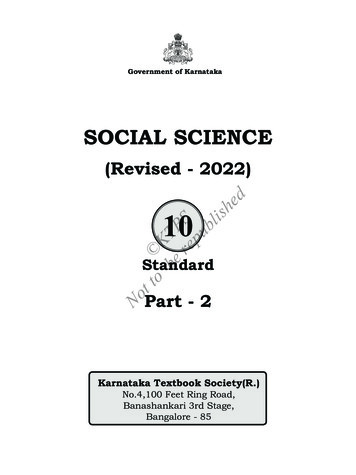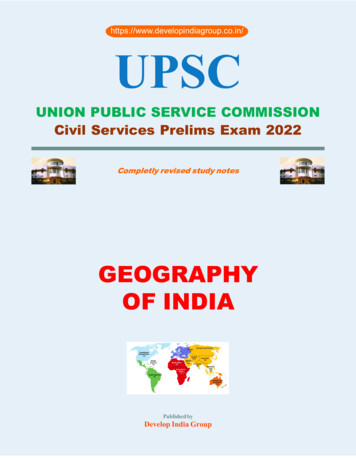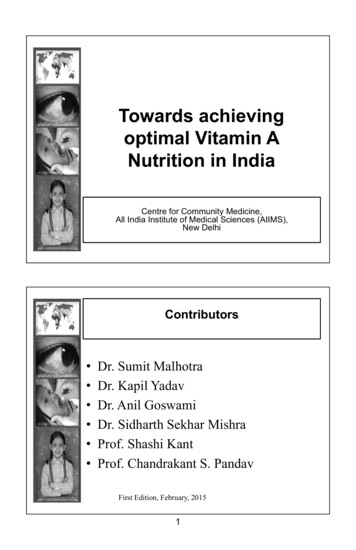
Transcription
Towards achievingoptimal Vitamin ANutrition in IndiaCentre for Community Medicine,All IIndiadi IInstitutetit t off MMedicaldi l SSciencesi(AIIMS)(AIIMS),New DelhiContributors Dr. Sumit MalhotraDr. Kapil YadavDr. Anil GoswamiDr Sidharth Sekhar MishraDr.Prof. Shashi KantProf. Chandrakant S. PandavFirst Edition, February, 20151
Outline IntroductionI t d ti tto VitaminVit i A Vitamin A Deficiency Disorders (VADD) Burden of Vitamin A DeficiencyDeficiency Global and India Strategy for Prevention and Control of VADD Millennium Development Goals(MDGs)Goals(MDGs),Copenhagen Consensus Vitamin A Supplementation Programme in India Way forwardOutline Introduction to Vitamin A– Historical Milestones– Functions, metabolism– Sources of Vitamin A– Recommended Dietary Allowances of Vitamin A Vitamin A Deficiency Disorders(VADD) Burden of Vitamin A Deficiency- Global and India Strategy for Prevention and Control of VADD MDGs, Copenhagen Consensus Vitamin A Supplementation Programme in India Way forward2
Vitamin A Vitamin A is a micronutrient belonging to group of fatsoluble vitaminsgrowth and differentiation of followingg bodyy Essential for gcells– Retina (vision pigment)– Respiratory epithelium lining– GastrointestinalG t i t ti l ttractt– Immune systemForms of Vitamin A VitaminViti A isi foundfd iin ttwo principali i l forms:f– Retinol Found in animal food sources Yellow, fat-soluble substance Pure alcohol form is unstable, found in tissues in aretinyl ester form Commercially produced as esters - retinyl acetate andpalmitate– Carotenes Alpha, beta, gamma-carotene; and xanthophyll betacryptoxanthin (all of which contain beta-ionone rings) Pro-Vitamin A in herbivores and omnivore animals,enzyme 15-15'-dioxygenase1 1 ' dicleaveslbbeta-carotene ini thehintestinal mucosa and converts it to retinol3
Chemical Structure of Vitamin AVitamin A alcoholß - CaroteneVitamin A: Historical milestonesYYear1913M j milestonesMajoril tDiscovery of Vitamin A by Elmer McCollum,Marquette DavisFat soluble nutrient in butter fat, cod liver oil1930Discovery of beta carotene and Vitamin A structurebyy Paul Karrer1947Industrial Synthesis of Vitamin A1964First global survey of VADD1980sVitamin A linked with child mortality4
Vitamin A: Historical milestonesYYearM j MilMajorMilestonest1987WHO advocates Vitamin A with measlesvaccine in Vitamin A deficient countries1990sReduction of maternal mortality with retinol/beta-carotene supplements1998WHO launched the global Vitamin Ainitiative2000Millennium Development Goals(call for reduction of nutritional problems)2008Copenhagen challenges solutionFunctions of Vitamin Ain Human BodySystemVisionFunctionLight and Dark adaptationCellular differentiation Gene transcriptionmorphogenesisImmune responseNon-specific, cell metabolism(anti infection vitamin and is vitalfor survival )HHemopoeisisiiIIronmetabolismb liGrowthSkeletalFertilityMale and FemaleThyroid metabolismRegulation of Thyroid StimulatingHormone(TSH) secretionAnti-oxidantScavenger of free radicals5
Vitamin A Metabolism (simplified)90% of ingested retinol and 70% of carotenes areabsorbedAbsorbed Vitamin A is stored in liver as retinyl palmitateZinc required for mobilization of retinyl palmitate tofree retinolRetinol transported in bloodblood, boboundnd to a retinol bindingprotein and travels to target tissueRhodopsin- Retinal visual cycleand role of Vitamin A The pigment epithelium layer of the retina in the eye isstorage site for Vitamin A.ReconstitutedRhodopsin(Visual purple)Light ExposureDegradedRhodopsinVitamin A dependant Diet deficient in Vitamin A leads to deficient rhodopsinreconstitution, interfering with vision especially in dimlight.light6
Rhodopsin- retinal visual cycleand role of Vitamin A (contd.)Photoreceptor(Rod) Cell11 – cis retinal11 – cis retinal11 – cis retinolAll trans retinylesterAll transretinolInter ReceptorRMaatrixCapillaryRetinal PigmentEpitheliumAll trans retinolRhodopsinOpsinOpsin All trans retinalAll trans retinolSources of Vitamin A MilkAnimal LiverSources Egg(retinol)Plant Green leafysources vegetables(carrots)((beta Yellow fruitscarotene)7LIGHTNeuronallSignallingVISION
Breast milk- important source ofVitamin A for neonates Colostrum 3 times richer in Vitamin A and ten times richerin beta-carotene Transitional breast milk contains doubledo ble the vitaminitamin A ascompared to mature milk Mature breast milk also rich source of Vitamin ARecommended Dietary Allowance (RDA)of Vitamin A for IndiansGroupParticularsVitamin 0Lactation9507600Infants0 -12 months3502800Children1-6 years4003200Adults 7 years6004800WomanSource: NutrientSN i RRequirementsianddRRecommendedd d DietaryDiAllAllowancesfforIndians. National Institute of Nutrition, Hyderabad. 20098
Outline Introduction to Vitamin A Vitamin A Deficiency Disorders (VADD)– Causes– Infection and VADD- Cycle– Xerophthalmia and its spectrum– Vitamin A and Anaemia– Vitamin A and Child Survival Burden of Vitamin A Deficiency- Globally and India Strategy for Prevention and Control of VADD MDGs, Copenhagen consensus VitaminVit i A SSupplementationlt ti PProgramme iin IIndiadi Way forwardCauses of Vitamin A Deficiency-1Lack of Vitamin A in the diet Vitamin A rich foods seasonal/ expensive Vitamin A rich foods not given to young children Infants not breast fed, or weaned before 4-6 monthsof agePoor DietDiets low in fat, protein, zinc or essential nutrientsnecessary forf absorptionbti andd utilizationtili ti off VitVitamini A9
Causes of Vitamin A Deficiency-2Illness(Mal-absorption of Vitamin A and fat) Prolonged diarrhea Severe Protein Energy Malnutrition Measles Acute lower respiratory tract infections Roundworm and other parasitic infectionsVitamin A Deficiency:Conceptual Framework10
Cycle of Infection and Vitamin ADeficiency DisordersINFECTION INCREASED METABOLICDEMANDS DECREASED APPETITE DECREASED ABSORPTIONREDUCEDRESISTANCE TOINFECTIONVITAMIN ADeficiencyVitamin A Deficiency Disorders(VADD) CycleAdults Low preformed Vitamin A Low fat Low Vitamin E ParasitesLOW VITAMIN A STATUSPregnancy Increased needs Food taboosLOW FETAL STORESYoung Child Increased needs for growth Malnutrition Infections Parasites Poor intake11VADD
Xerophthalmia Signifies dry eye All the clinical signs and symptoms that affect the eye inyVitamin A Deficiency Parts that are affected in the eye are– Conjunctiva (Bulbar)– Cornea– RetinaWHO Classification ofXerophthalmiaClinical findingWHO ClassificationNight BlindnessXNConjunctival XerosisX1 ABitot’s spotX1 BCorneal XerosisX2Cornealulceration/Keratomalacia 1/3 of cornealsurfaceX3 A 1/3 of corneal X3 BsurfaceCCorneallSScarCSXerophthalmic fundusXF12
Night Blindness (XN) Often the first symptom– indicative of retinal dysfunction Leads to subjective impairment of vision in nightConjunctival Xerosis (X1 A) Range of dryness to keratinization of conjunctiva in formof thickening, wrinkling and pigmentationChangesa ges in tthee pproteinsote s aandd secsecretoryeto y cellsce s C Can lead to infections inthe eye13
Bitot’s Spots andCorneal Xerosis (X2)Bitot’s spotsDryness and foamy/ Cheesyaccumulationsl tion theth innerieyelidsCorneal XerosisDullness or cloudy corneaT tTextureoff ththe cornea dryd anddroughKeratomalacia Softening, ulceration on the cornea Perforation of the cornea A medical emergency Leads to blindness14
Corneal Scar (CS) Healed sequelae of prior corneal disease related to VitaminA Deficiency– Opacities or scars of varying density (nebula,macula, leukoma)– Weakening and out pouching of the remainingcorneal layers (staphyloma and descemetocele)– Phthisis bulbi Not specific for xerophthalmia, also caused by trauma andinfectionXeropthalmic Fundus (XF) Small white retinal lesions Described in some casesof VADD May be accompanied byconstriction of the visual fields Largely disappear within2- 4 months in response toVitamin A therapy15
Night Blindness ScreeningQuestionnaire (WHO)Does your child have anyproblem seeing during nighttime?NoYesIs this problem different fromother children in yourcommunity? (appropriate whereVADD isi nott prevalent)l t)Does your child have night blindness ?(use local term- Rathondi in Hindi/Recheekati/ night eyes/ chicken eyes)Criteria for assessing the public healthsignificance of Xerophthalmiaand Vitamin A DeficiencyCriteriaMinimum prevalenceamong children 6yrs inthe communityClinical (primary)Night Blindness (XN)1.0%Bitot’s spot (X1B)0.5%Corneall XerosisCXi and/ord/ ulceration/li /keratomalacia (X2 X3A X3B)0 01%0.01%Xerophthalmia related corneal scars(XS)0.05%Biochemical (supportive)Serum retinol (Vitamin A ) less than0.35 micromol/ L (10 microgm/dl)165.0%
Vitamin A and Anaemia Multiple apparent roles of Vitamin A– Iron mobilization and transport– Formation of blood cells: haematopoiesis(enhancement of growth and differentiation ofyy progenitorp gcells))erythrocyte– Potentiation of immunity to infection andreduction of the Anaemia of infection– Mobilization of iron stores from tissuesVitamin A and Anaemia Epidemiological surveys show that the prevalence ofanaemia is high in populations affected by VADD indeveloping countries Improvement of Vitamin A status has generally beenshown to reduce anaemia17
Vitamin A and Child Survival Vitamin A supplementation leads to reductionin child mortality– 24% reductioni iin all cause mortalityi(RR 0.76, 95% CI 0.69 to 0.83)– 28% reduction in diarrhea relatedmortality(RR 0.72, 95% CI 0.57 to 0.91)Source: Mayo-Wilson E, Imdad A, Marshall KH, Yakoob MY, Bhutta ZA,Sheriff N.N Vitamin A supplements for preventing mortalitymortality, illness and blindnessin children aged under 5: systematic review and meta analysis. BMJ2011;343:d5094 doi:10.1136/bmj.d5094Vitamin A supplementation andreduction of child mortalityOutcomesRelative Risk(95% CI)All Cause mortalityF ll up: 12-96Follow12 96 weekskRR 0.76(0.69-0.83)(069 0 83)All Cause mortality(HIV Children)Follow up: 6-24 monthsRR 0.55(0.37-0.82)Diarrhea related mortalityFollow up: 48-104 weeksRR 0.72(0.51- 1.24)Measles related mortalityFollow up: 52-104 weeksRR 0.80(0.51-1.24)Lower respiratory tractinfection-related mortalityFollow up: 48-104 weeksRR 0.78(0.54-1.14)18
Vitamin A supplementation andreduction of child morbidityS.NoReduction in ChildMorbidityStatistical Data1Reduced incidence ofdiarrheaRR 0.85, 95% CI 0.82 to 0.872Reduced incidence ofmeaslesRR 0.50, 95% CI 0.37 to 0.673Reduced prevalence ofvision problemsincluding :a. NightblindnessRR 0.32, 95%CI 0.21 to 0.50b Xerophthalmia RR 0.31,b.0 31 95%CI 0.22 to 0.45Vitamin A SupplementationBenefit- risk balanceIncreasedrisk ofvomiting infirst 48 hrs(RR 2.75,750.81 to 4.19)Reductionof childmortalityandmorbidity19
Outline Introduction to Vitamin AVitamin A Deficiency Disorders (VADD)Burden of Vitamin A Deficiency- Global, IndiaStrategy for Prevention and Control of VADDMDGs, Copenhagen ConsensusVitamin A Supplementation Programme in IndiaWay forwardGlobal Burden20
Global Burden of Vitamin ADeficiency in childrenIndicatorNumbersaffectedSourceLow Vitamin A status(Serum Retinol 0.70 micromole/L)190 millionWHO 2009Night Blindness5.7 millionWHO 2009Clinical Xerophthalmia4.4 millionWestDarnton-Hill2008Blindness due to VADD0 4 million0.4Sight and Life2012Global Burden of Vitamin ADeficiency in children Vitamin A Deficiency in newborn, infants and childrenresponsible for– 6% of under-5 deaths– 5% oof uunder-5de 5 DALYss– 1.7% of total DALYs lost Vitamin A Deficiency alone is responsible for almost 8%off childhild deathsd h ini SouthS h EastE AsiaA i andd 6% iin AfAfricai(WHO)DALY- Disability Adjusted Life Years21
Global Burden of VADD in PregnancyIndicatorNumbersaffectedSourceLow Vitamin A Status(Serum Retinol 0.700 70 micromole/L)il /L)19.1 millionWHO 2009Night Blindness9 75 million9.75WHO 2009Night Blindness Prevalence Worldwide (1995-2005)Source WHO 200922
Subclinical Vitamin A Deficiencyprevalence world wide (1995-2005)Source: WHO 2009Burden in India23
National Institute of Nutrition Survey2002-05 Eight states 71,591 pre-school children examined National prevalence of VADD - 2.3% Highest in Madhya Pradesh (6.6%), West Bengal (3.8%) Prevalence of sub-clinical VAD 62%(serum retinol 20microgm/dl)24
Prevalence of clinical and subclinicalVAD and low intake of Vitamin A by statesPrevalence (%)Bitot’sSpotConjunctivalXerosisSerum Retinol 0.7micromole/.lVitaminA intake 50%Andhra 00.052.186.1Kerala0.50.579.482.1Madhya ha0.00.057.774.4Tamil Nadu0.00.048.863.6Uttar Pradesh0.50.5-80.2West Bengal0.33.161.265.0Determinants of VADD TheTh oddsdd off bitot’sbit t’ spotst higherhi h among childrenhild– With family size of more than four– Illiterate mothers– Households without a sanitary latrine– Not received even one dose of Vitamin A supplementation– Belonging to backward communitiesSSource:LLaxamaiahi h A ett al.l PrevalencePloff ocularl signsiandd subclinicalb li i l vitaminit i ADeficiency and its determinants among rural pre-school children in India.Public health Nutrition 2011;15:568-57725
The Central India ChildrenEye Study-2011 11,829 school children from Nagpur XXerophthalmiah h l i (conjunctival( ji l xerosis,i bitot’sbi ’ spot,corneal xerosis) and/ or night blindness seen in 13.4%childrenSource: Sinha A,A Jonas JB,JB Kulkarni M,M Nangia V.V Vitamin A Deficiencyin school children in Urban Central India: The Central India Children EyeStudy. Arch Opthalmol 2011; 129 (8): 1095- 1096.Night Blindness in pregnancyCoverage Evaluation survey 2002 Reported in 12% of females during pregnancy Higher proportion in rural areas and among illiteratewomen Proportion was high (upto 20%) in Bihar, Jharkhand,y PradeshUttrakhand and MadhyaSource: Coverage Evaluation Survey (CES) 200226
High risk population andvulnerable groups Infants and children– Increased Vitamin A requirement to support rapidgrowth and– Too assassistst in fightingg t g againstaga st infectionsect o s Pregnant and lactating women Persons affected with drought and other disastersOutline Introduction to Vitamin AVitamin A Deficiency Disorders (VADD)Burden of Vitamin A Deficiency- Global and IndiaStrategy for Prevention and Control of VADD– Vitamin A Supplementation– Fortification– Long term dietary approaches MDGs, Copenhagen Consensus Vitamin A Supplementation Programme in India Way forward27
Vitamin A supplementation as publichealth intervention- Short term solution Vitamin A supplementation is– Cost-effective– Safe– Sustainable– Easily implemented on a national scale Over 6,00,000, ,lives can be saved each yyear 20 million disability adjusted life years can be gainedAvailability of Vitamin Afor supplementation Syrup Capsules Tablets Injectables28
Vitamin A Syrup- Important Points Available in concentration of 1,00,000 or 2,00,000 IU Should be administered using 2ml spoon/dispenser Must be kept away from direct sunlight Stored in cold dark room temperature and is stable forminimum one year8 weeks Bottle once opened must be utilized within 66-8Vitamin A SupplementationSchedule for Indian ChildrenAgeDoseFrequency6 monthsto11 months1,00,000 IUOnce12 monthsto5 years2,00,000 IUEvery 6monthshSource: Vitamin A and IFA Supplementation. Ministry of Health andFamily Welfare, 2006.29
Why every 6 monthssupplementation is required? Body cannot make Vitamin A on its own– Vitamin A is stored in the liver Illness, if occurs, depletes stored Vitamin A Vitamin A stores lasts for 4-64 6 months onlyFood fortification with Vitamin A Fortification of staple foods such as– Wheat and rice and other grains– Vegetable oil– DairyD i ffoodsd– Margarine– Sugar30
Sugar FortificationGuatemala case study SugarSididentifiedifi d as theh bestb vehiclehi l forf fortificationf ifi i A special form of water soluble Vitamin A developed No negative taste, texture, color or flavor changes inthe final product CCriticali i l requirementiwas newsugar production factories toinstall customized equipmentto mix the Vitamin A into thesugarHome fortification Uses products such as micronutrient powders and lipidbased nutrient supplements Given to mother to add to the food traditionally eatenby the child in the homep Available as ppowders/ sachets/ sprinkles31
Improvements in Dietary intakeLong term solutionDietary improvementAimNutrition education/communicationi iChange the behaviour of the peopleHorticultural interventions(home food provisioning/home gardening)Increase availability of Vitamin Arich foodsEconomic/ food policiesAffecting availability, price andeffective demand of Vitamin A richfoodsTechnological advancesTo promote plant breeding andgenetic modification (eg.Genetically Modified rice)Outline Introduction to Vitamin AVitamin A Deficiency Disorders (VADD)Burden of Vitamin A Deficiency- Global and IndiaStrategy for Prevention and Control of VADDMDGs, Copenhagen Consensus– Links to MDGs and Copenhagen consensus– Economics of Vitamin A supplementation– Progress with Vitamin A supplementation Vitamin A Supplementation Programme in India Way forward32
Millennium Development Goalsand Vitamin AMDGGoalRole of Vitamin AGoal 4 Reduce ChildMortalityVitamin A reduceschild mortalityGoal 2 Achieve universalprimary educationVitamin A preventschildhoodblindnessCopenhagen Consensus (2008)Ten challengesAir PollutionGlobal WarmingDiseasesWomen andDevelopmentEducation4 out of 10solutionswere relatedto Vitamin AMalnutrition andHungerSubsidies andtrade barriersSanitation andWaterTerrorismConflicts33
Copenhagen Consensus (2008) 40 Solutions considered1.Micronutrientsupplementsfor children(Vitamin Aand Zinc)3.Micronutrientfortification(iron and salt)Foursolutionsrelated tomalnutritionVitamin Asupplementaltion tops CommunitybasednutritionpromotionCopenhagen Consensus (2012):Hunger and Malnutrition For about 100 per child, bundle ofinterventions could reduce chronic undernutrition by 36 % in developing countries––––Micronutrient provisionComplementary foodsTreatments for worms and diarrheal diseasesB h iBehaviourchangehprograms Merged the intervention of Research andDe elopment to increase yieldDevelopmentield enhancements34
Economics of Vitamin ASupplementationRegion (s)Total cost ofsupplementation per childper year ifVitamin A coverage20-80%Total cost ofsupplementation perchild per year ifVitamin A coverage80-90%South Asia, SubSaharan Africa,East Asia 1.20 2.40Central Asia 1.601 60 3 20 3.20Latin America andthe Caribbean 2.60 5.20* Cost of programs involving outreach, assuming that 20% ofcoverage can be done with routine health servicesCost benefit ratios andregional variationsRegion (s)Vitamin Acoverage20-80%Vitamin Acoverage80-90%S th Asia,SouthAiSub-Saharan Africa,East Asia17 117:1919:1Central Asia 13:1 6:1Latin America and theCaribbean 8:1 5:1DALY value of 1000 is used throughout35
Progress with Vitamin A Supplementationfor children aged 6-59 monthsStill almost one thirdof children don’treceive two doses ofVitamin AOutline Introduction to Vitamin AVitamin A Deficiency (VADD)Burden of Vitamin A Deficiency- Global and IndiaApproaches to Prevention and Control of VADDMDGs, Copenhagen Consensus and Vitamin AVitamin A Supplementation Programs in India– History and strategy– Coverage– Lessons learned Way forward36
National Vitamin ASupplementation Programme Launched by Government of India in 1970 To prevent nutritional VADD blindness National Programme for the Prevention of NutritionalBlindness Included short term and long term strategiesShort Term StrategySupplementation with Vitamin A Every infant 6-11 months and child 1-5 yearsadministered Vitamin A every 6 months A child to receive a total of nine oral doses of VitaminA by its fifth birthday37
JOINTMOTHERCHILDHEALTHCARD TORECORDANDMONITORADMINISTRATIONOFVITAMIN ATOCHILDRENTreatment of Vitamin ADeficiency in Children All children with clinical signs of Vitamin ADeficiency must be treated as early as possible Administer 22,00,00000 000 IU of Vitamin A to child 1 year of age immediately after diagnosis, ,IU of Vitamin A To be followed byy 2,00,0001-4 weeks laterSource: Vitamin A and IFA Supplementation. Ministry of Health andFamily Welfare, 2006.38
Vitamin A and Measles All children suffering with measles should receive twodoses of Vitamin A One dose (50 000 IU for infants aged less than sixmonths, 100 000 IU for infants aged 6-11 months, and200 000 IU for children aged 12 months) On the day of measles diagnosis, and one dose on thefollowing dayPartnerships in implementation ofVitamin A program in India H lth systemHealtht Nutrition- Integrated Child Development Services (ICDS) Education Civil Society Non Governmental Organizations (NGOs) International partner agencies Industry Agriculture Media39
Low Coverage of Vitamin A in IndiaAge groupDose ofVitaminAPre-school One dosechildreninprecedingyear12-23monthsFirst9 239-23monthsDose inlast 6monthsPlaceYear andAuthorSamplesizeCoverage(%)8 12280948 4%48.4%Vitamin A Coverage Trends in IndiaSurveyCoverage Evaluation Survey(CES)Ever received Vitamin A(%) Children age 12-23 monthsCES 200240CES 200554CES 200658CES 20096540
Determinants of Vitamin A coverageDeterminantResultsAge of MotherMothers age’s 35 years ( 50% Vitamin A coverage)compared to mothers 35 years ( 60% coverage)Sex of childNo gender differential in coverageBirth orderAs the birth order increased the chances of the childreceiving Vitamin A decreasedPlace ofResidenceRural areas lagged behind the urban area by nearly 3%Mother’seducationd tiVitamin A coverage improved with increase in motherseducationsd ti* CES 2009Determinants of Vitamin A coverage(cont.)DeterminantResultsReligious groups Islam Christianity Hindus Sikhs OtherReligious groupsSocial groupsSC OBC ST OthersBPL cardsFamilies having BPL cards faired better by2 to 3% over those who didn't have itWealth IndexFamilies on higher wealth index hadgreater coverage41
State-wise Vitamin A CoverageGood performingstates ( 80%)Poor performingstates( 60%)1.2.3.4.5.6.1. Arunachal Pradesh2. Nagaland3. Meghalaya4. Manipur5. Uttar Pradesh6. Bihar7. Madhyadh Pradeshd h8. Rajasthan9. Haryana10.Tamil Nadu11.Jammu KashmirAndhra PradeshGoaMaharashtraKarnatakaHimachal PradeshSikkimCoverage with Vitamin A:First DoseSource: Coverage Evaluation Survey 2009 UNICEF42
Coverage Evaluation Survey 2009Availability of Vitamin A inpublic health facilities of India A survey in 2010 of 129 health facilities 102 (79.1%) facilities had liquid Vitamin A at the timeof visitEnsuring availability of supply of VitaminA is still a concern inIndian public health facilitiesSource: Gitanjali B et alal. Availability of five essential medicines forchildren in public health facilities in India: A snapshot survey.Journal of Pharmacology and Pharmacotherauptics 2011;2:95-9943
Vitamin A Supplementation (VAS)programme coverage (%) [UNICEF]200720082009201020112012Andhra 38676420Kerala--11081620Madhya 385839792Tamil Nadu571107696111Uttar Pradesh14165204938West Bengal6464672205National335766346763Full VAS coverage by povertyconcentration quintile, 2006-11 (%)[UNICEF]District poverty concentration quintileYearLowestLowerMiddleHigherHighest200650 050.041 341.347 247.247 547.537 54.444
Vitamin A supplementation programevaluation- IPEN/ AIIMS key findings Lack of conceptual clarity amongst providers aboutdosing, schedule and clients Complacency of the providers that they have achievedadequate coverage and no problems in implementationgshort/ surplusp suppliespp Irregular/ Problems with spoon- same usage by multiplechildren, clients preferred dispensersOutline Introduction to Vitamin AVitamin A Deficiency Disorders (VADD)Burden of Vitamin A deficiency- Global and IndiaApproaches to Prevention and Control of VADDMDGs, Copenhagen Consensus and Vitamin AVitamin A Supplementation Programme in IndiaWay forward45
Universal reach remains achallengechallengeNeed for extra mile tob id iinequitybridgeitWay forward Delivering Vitamin A supplementation (VAS):– Along with routine immunization– Special campaigns similar to Pulse Polio– At pointi t off contactt t withith healthh lth systemtduringd iroutine check ups for growth monitoring etc.– ASHA/ AWW should be utilised to providedoor to door service Strengthening logistics46
Accelerated Vitamin A andintegrated outreach Organizing child health days and weeks as a strategyfor integrating Vitamin A delivery with otherinterventions Packaging and inclusion in Integrated management ofnewborn and childhood illnesses (IMNCI)Accelerated Vitamin A andintegrated outreach(contd.)Vit i A deliveryVitamind lican bbe combinedbi d with:ith De-worming Immunization Treatment of anemia Malnutrition management Insecticide treated bed net distribution Promotion of health practices at community level47
Benefits of child health week/ days asdelivery for Vitamin A supplementation HighHi h achievementhioff VitaminVi i A coverage Focused-effective use of resources Increases coverage with other services Costs shared with other programsFocus on strengthening delivery of additional doseswith immunizationafter 9 months of ageCritical factors for high coverage withVitamin A Supplementation Programme Political Commitment Coordination between Health and Women child developmentdepartments District level micro-planning Procurement, supply and distribution of Vitamin A supplements Flexible dosing mechanisms Social mobilization and communication Training, supervision and monitoringSource: UNICEF48
Political Commitment Local leadership and ownership at state level Adequate funding to the programme Formulation of guidelines and standard operatingguidelines Active participation of concerned stakeholdersStrong Coordination Health Family Welfare and Women ChildDevelopment- two critical departments to work inclose synergy Joint coordination committees formulation Joint guidelines, planning and capacity building offrontline workers Team work between Auxillary Nurse Midwives(ANMs) and Anganwadi Workers (AWWs) forVitamin A delivery49
District Level Micro-planning Bottom up approach Creating list of eligible children in the village Defining logistical needs PlanningPl i ffor coveringi allll sitesit ini theth districtdi t i t Devising supportive supervisory plansProcurement, supply and distributionof Vitamin A supplements Efficient and stable procurement system foruninterrupted Vitamin A supply is critical Well laid out mechanisms for distribution fromdistrict to block to village levels Need for well designed programme implementationplans for Vitamin A supplementation programmes50
Flexible dosing for enhancingcoverage for hard to reach areas Mostly, dosing is done in many places through biannualroundsap out aall geoggeographicap c aareaseas Map Special efforts needed for reaching out to disadvantagedchildren Plans for hard to reach areas involving local communityvolunteers may be designed and executed Involvement of Non Governmental organizations andpartnerships may prove successful in enhancing coverageSocial mobilization andcommunication Communities need to be informed about purpose ofVAS programmes adequately. Media to be engaged positively In rural areas-drum beating, mobile public addresssystems, local community meetings, village rallies,home visits may be used to raise awareness.51
Training, supervisionand monitoring All staff involved in delivery of VAS should betrained - induction and refresher meetings Monitoring and supervisory teams should beconstituted Poor performing areas to be provided support forensuring high coverage Medical colleges may be engaged in this role apartfrom programmatic staffIn long run Increase production and consumption of– Green leafy vegetables– Other Plant foods rich in carotenoids Improve overall nutritional status of children52
soluble vitamins Essential for gggrowth and differentiation of following body cells – Retina (vision pigment) – Respiratory epithelium lining – Gt itti lt tGastrointestinaltract – Immune system Forms of Vitamin A Vit iAif dit iilfVitamin A is found in two
